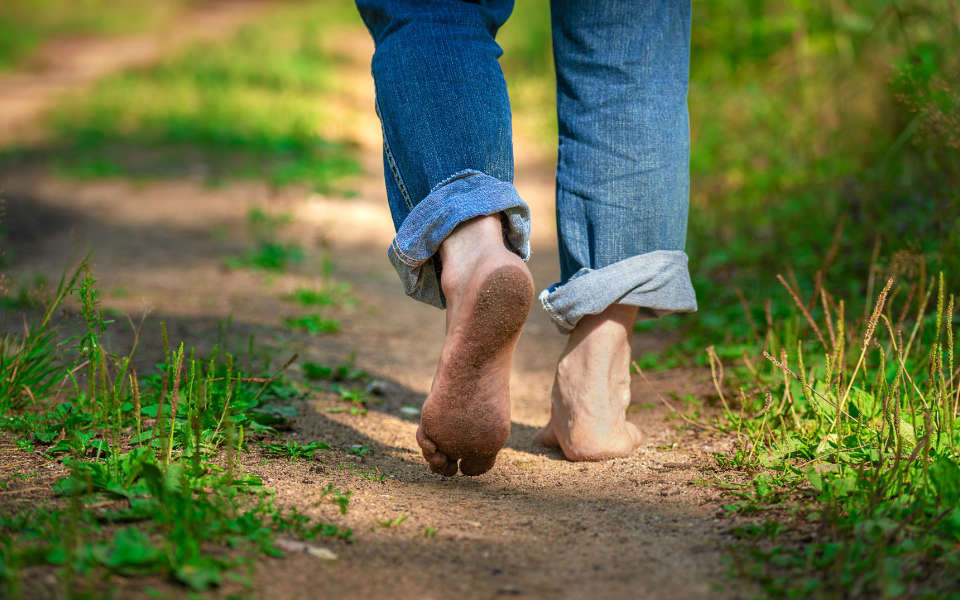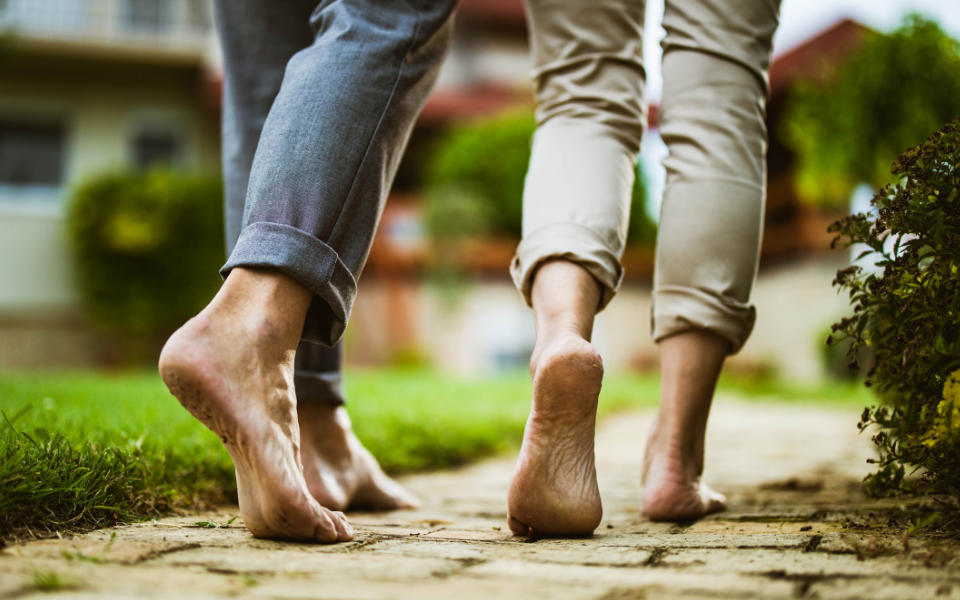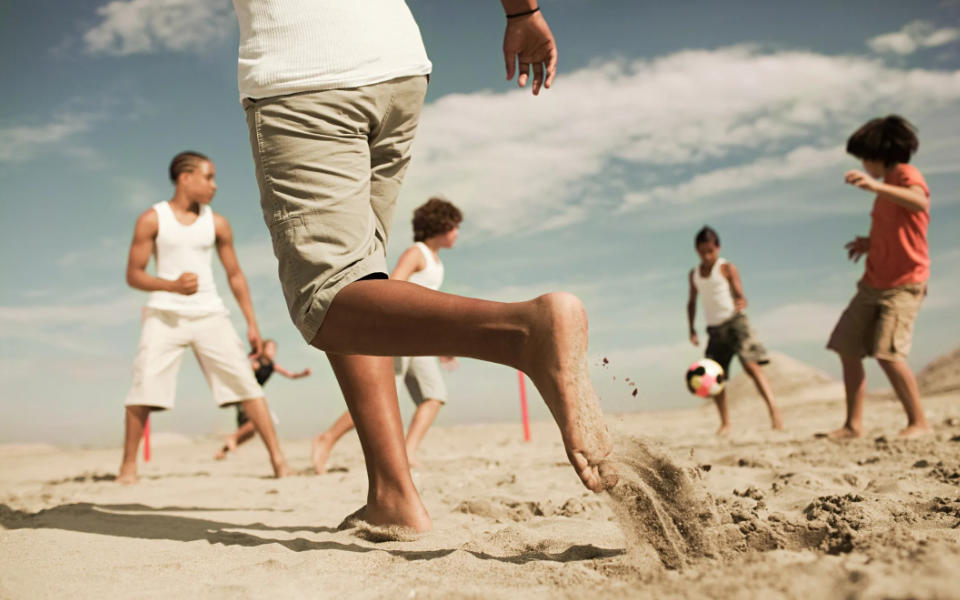Remember the phrase, back to basics? Well, that is what earthing or grounding is in a nutshell. Over the past years, the term earthing or grounding is making its way around Health and Wellness. As time went by, it has unfolded several health benefits that can significantly change a person’s overall health.
Who would have thought that this powerful tool is known to our grassroots since the beginning of time? For sure, it has developed into several ways and techniques, but in essence, they mean one thing, and this is to manifest the power of earthing.
Modernisation and industrialisation have detached the human body from the roots of the earth, literally and figuratively. Because of the demand and uptight dynamics that we are now settling in, earthing seems to be a luxury for some, if not, most people. To a certain extent, the idea or even the act of earthing might be impossible if a person lives in a more complex situation or resides relatively far from nature.
Yes, there’s so much to unpack here. This term might be non-existent before. But, since you’re now here, there are some of the truth bombs you need to know that comes with knowing what earthing or grounding is.
First, what is earthing?

Yes, earthing and grounding are one and the same. They are inter-changeable.
Now let’s hop into the interesting part!
One thing you need to understand is this, we are surrounded by free electrons. Yes, you read it right. The world we live in is filled with free electrons that are known to carry negative charge. These free electrons, once in contact with the human body, create a well-balanced effect, reducing the risk for diseases and having an unwavering effect in reducing the risk for development of inflammation.
When the human body is cluttered with free radicals, also known as reactive oxygen species (ROs), it eventually builds up as inflammation that opens the door for the threat of having diseases over time.
Hold up!
Inflammation is not always completely harmful. If a person suffers from injury or trauma, inflammation has to take place before healing begins. However, if the body is exposed to prolonged inflammation internally, that’s where the fall out begins.
Now, to get the ball rolling:
To further simplify what earthing is, it’s basically walking barefoot to the ground. It is the physical contact of the human body to the ground. This happens to be a fundamental habit to one’s overall health!
This is why earthing or grounding stands out.
With the help of earthing or grounding, the contact of the body to the ground creates an equilibrium where free radicals are nullified by the antioxidants from the free electrons found in the ground. To make it even more simple, earthing or grounding can be a therapeutic way of reducing risk for diseases, now considered as a care plan by healthcare professionals. So yes, earthing creates a solid foundation that makes up a person’s overall health.
What are the benefits of earthing?
Straight up, earthing provides hyperdrive of antioxidants that fight off free radicals, causing inflammation leading to diseases. Yes, that’s one of the most powerful benefits of earthing!
Earthing or grounding will not be recommended by tons of health experts if not for its known benefits. It actually has become so proactive, that it can even delay or even prevent the onset of life-changing diseases or serious physical injury.
Also, earthing is something that we, humans are closely attached to because of our origin where our ancestors used to reside very close to nature (and even forests!). Over the years, earthing has established its importance as part of an ideal treatment plan or regimen to maintain good health.
Here are some of the health benefits that earthing promotes:
1. Earthing can reduce inflammation
Of course, not all inflammation will put the body off. However, the body cannot really handle internal forms of inflammation, especially for a long period of time. There are countless studies that have concluded how prolonged development of free radicals inside the human body can dramatically whack the mechanical processes, leading to dysfunctions.
What earthing does is simply stabilise the load of free radicals inside the body. It generates active flow of free electrons that might be the culprit of chronic inflammation over time.
In most instances, inflammation is always attached to feelings of pain. This is nonetheless true in the aspect of earthing. Why? It’s proven that earthing or grounding reduces pain from inflammation specifically to athletes with bad cases of muscle soreness during training or workout. It creates a spot-on nerve impulse that stimulates rest and recovery for the muscles which promote anti-inflammatory chemical reactions in particular areas of the body of an athlete.
2. Earthing improves blood flow
It’s already written in stone that impaired blood flow is closely associated with cardiovascular disease. Because of our limited access to places or land areas where substantial grounding or earthing can be conducted, it has become almost impossible to introduce this for most people.
This is the other side that needs to be out in the open: Earthing or grounding creates a rhythm that only the human body can appreciate. It bridges the gap where the nerve impulses are directly immersed to the ground naturally making the body’s blood flow more efficient.
There are groundbreaking facts saying that earthing or grounding can impact lowering the blood’s viscosity. This phenomenon has to be as consistent as possible when maintaining a healthy disposition physiologically.
Here’s the cherry on top!
Habitual grounding or earthing sends signals in the autonomic nervous system. This integral part of the nervous system navigates the body’s heart rate, which then promotes optimum health and can definitely prevent the onset of cardiovascular diseases. This is the exact reason why people battling issues with the cardiovascular system are encouraged to do earthing to help speed up recovery.
3. Earthing improves sleep
It might be fair to say that sleep is electric (in a good way!). Because earthing has its own unique way of turning one’s health upside down (again, in a very good way), this can effectively change sleep patterns.
In this aspect, cortisol, or the hormone that has full control over stress and even mood swings, is known to considerably decline with grounding. Because of the known fact that grounding itself can reduce inflammation, so thus with the body’s level of cortisol. Grounding can easily lower stress that may eventually lead to a long list of diseases with high mortality rates.
Grounding is one of the components that can make sleep worthwhile in more ways than you can imagine. Not only it stimulates normal circadian rhythm that prompts the body when to rest and how much rest is actually needed to recuperate. There’s actually more to it.
Grounding can help strengthen the connection between the human body, the mind, and its nerve impulses that stimulates normal sleep cycle. It simply creates a smooth send-out of signal on when the body needs to rest, and of course how much rest the body needs to recover. Moreover, the snowball effect of having a better disposition and improved mood are two other remarkable benefits of grounding. This might be the perfect blend for a person to lower the risk of anxiety and depression later on.
When should you do earthing?

There are tell-tale signs that you must be “grounded”. These are indicators that a person has been experiencing a hyperdrive of inflammation, or its cortisol is at all time high. Because of the known benefits of grounding, it makes a lot of sense to take some time to step back and figure out a way to do earthing or grounding.
Here are some of the indicators:
- Onset of disease
- Emotionally drained with petty things
- Feeling very stressed over a long period of time
- Lingering mood swings
- Lack of sleep
- Weight gain
Generally speaking, these observations may come as inevitable in day-to-day life. This is where the idea of finding the right balance in life has to be one’s ultimate goal at some point. For some, scheduling or booking a vacation and rest are two simple steps closer to grounding. This alone creates a huge change to promote balance and stimulate the production of happy hormones. This chain of chemical responses in the body leads to great improvements!
How to effectively do earthing?
A habit cannot work seamlessly without the right dose of things that need to be done in an effective manner. Grounding, as it is, seems to be easy for individuals who are given the luxury of space and access to nature. This may not be the case for some, if not, most people living in the city, those that are attached to chaos and fast-paced lifestyle.
Here are a few things that can actually flip things a bit, whether you’re close to nature or not!
1. Get some sun
With the countless pieces of evidence that tell you how powerful Vitamin D can be in optimising immune health, it’s an understatement how impressive the results can get when you combine that with grounding.
When the body gets the right amount of Vitamin D, coupled with the timely exposure to earthing or grounding, the body’s hormones particularly serotonin and dopamine, up-regulates at a desirable rate. This exact occurrence decreases onset of pain, delays inflammation and can even fix up the sleep hormone or melatonin which brings a dynamic effect in the long run.
Regular sun exposure can also activate the body’s capacity to have an uplifted disposition if grounding will take place in the morning. Since the sun is one of the resources that almost all people would have equal access to. Whether you are residing in a remote area, or in a city filled with buildings, the sun would most likely be present in most areas across the globe. This is already more than enough to get you going and have that boost in happy hormones to sustain the habit of earthing.
2. Find a safe space
Finding a safe space for earthing or grounding may come out as a hiccup or a major setback for people living in a concrete jungle. However, grounding doesn’t have to be always around nature. In most instances, having a nook or quiet space in your flat which is conducive enough to immerse yourself into grounding can really do wonders.
A cozy, calm space in your room or maybe balcony can take the place for your grounding spot. In a nutshell, the space allotted for grounding would include not just the physical aspect but mostly the mental state of mind. Space for grounding has to be closely associated with earth, where you truly feel calm and steady.
For people living with very limited space, filled with buildings and walls, it makes so much sense to ground-proof a delegated space wherein it is considerably quiet, clutter-free, and calm. More and more people are already getting intentional in this aspect, over the years. Some individuals would purposely soundproof their grounding area, fill them with plants to simulate the serene vibe of nature, reduce sources of blue light, and even use earthing mats to literally stay grounded while barefoot.
3. Stay focused
When you do earthing, it’s very important to be present and stay still at a given time. For some, they look for the focal point where their focus would be best stimulated. There are people who love setting up stones to keep them focused while earthing or grounding.
Over time, it has evolved to more stuff that stimulates attention like a candle, tea, calming scent, or as simple as a pillow that’s meant to do one thing, to stay focused, still and calm to further stimulate the person’s environment, and eventually with the purpose of the mind following through the process which is vital in the act of earthing or grounding.
Keeping the vibe of being focused, calm and relaxed can then reduce the level of cortisol in the body. This helps in up-regulating the body’s happy hormones (serotonin, dopamine, oxytocin and endorphins), which is of course the end goal of maintaining the habit of earthing or grounding.
This can easily be done if a delegated space is conducive enough for earthing to take place. For some people, it’s even more helpful when earthing is done by a group. It builds a sense of belongingness that a habit is built within a small group of people, which is not bad at all!
Are there other ways that help with earthing or grounding?
When we speak of modalities, let’s think of it this way. These are ways or practices that make so much sense in maintaining healthy habits including earthing. These habits are so formative that it creates a solid foundation for you to have an epic success story in your journey towards healthy living.
Keep in mind that these meaningful habits help in having a sustainable way of life which is fundamental in the long run.
In hindsight, the act of earthing or grounding seems to be demanding for physical capabilities. With that being said, there must be modalities set in place before even considering the practice of earthing or grounding.

Here are some:
1. Eat healthy
This tip can never go wrong. As we all know, food is fuel. Your body is a running engine that generally would need unbeatable fuel that enables you to efficiently conduct grounding, in any form you wish to do.
Having the right kinds of macronutrients namely carbohydrates, protein and fat, the body can perform at its best which can change the game in building habits like earthing or grounding. Moreover, the proactive capacity of the micronutrients, including the long list of vitamins and minerals can do great things for the machineries inside the body to function seamlessly. If this modality goes smoothly, paired with timely earthing, the body can systematically build normal release of desirable hormones (serotonin, dopamine, oxytocin and endorphins). These hormones are gifted with their innate capacity to sweep off free radicals outside the body which cause an unimaginable number of diseases over time.
2. Seek help
Seeking help is actually just the tip of the iceberg. Earthing or grounding allows an individual to connect and eventually create a meaningful relationship, not only within the earth’s surroundings, but also through fruitful relationships. With this adaptive capacity of humans, stress can really become an innate part of someone’s life, but not destructive enough to be a threat of disease.
Basically, seeking help creates a healthy cycle wherein a regulated dose of happy hormones (serotonin, dopamine, oxytocin and endorphins) can significantly balance out the level of stress hormone (cortisol). Having like-minded people who enjoy grounding just as much as you make the journey more meaningful than what you’re actually expecting. It builds a solid foundation to determine if earthing is something you will do in the long run, which in turn can make it sustainable enough to establish a very good routine.
Another level of seeking help is having a professional support system that regularly checks your physical health, reassuring you that you are well enough to earthing or grounding. Since some strategies in doing so would require outdoor adventure, it’s always best to have healthcare providers who would check your physical stature to enjoy grounding especially when it’s done outdoors.
3. Stay active
Finding a sweet spot where it set your mind to stay active can be vital in every aspect of earthing. For one, it makes grounding even more dynamic since it heals not only internal inflammation, but also external inflammation from injury or any form of pain.
Next, it keeps the balance where the body can regularly generate a set of hormones which improve mood and manage anxiety. This allows the body to have a very good system in place. It can result in a more positive outcome performance wise. Since earthing can be done in a number of ways, it brings more benefits if a person is physically capable of trying out other modalities when it comes to earthing.
In addition to what physical activity can work hand in hand with earthing is breathing. With an adequate rate of physical activity together with habitual earthing, it produces the right mechanism and the body will more likely improve the right airflow throughout the whole system. Improved airflow improves the body’s lung capacity which triggers a more positive result to flow of oxygen, which the body needs for optimal health.
How can you practice earthing?

Embracing the Science behind earthing or grounding can only do so much. At some point, you need to get yourself together and can that huge leap to actually start the habit of earthing.
Undeniably, a habit is pretty much hard to develop if it seems complicated. Worry no more, this part actually breaks down the simple stuff that should be done with minimal effort. This can definitely kickstart the habit the earthing, changing your habits, one day at a time.
1. Stand or walk barefoot
This might be the gold standard when we speak of earthing and grounding. The act of literally stepping your feet on the ground forms physical contact of the body to the ground which generates an exchange of antioxidants coming from the ground to the body. This is the ultimate goal of grounding.
The idea of keeping your feet on the ground is vital in sending signals to several parts of the body to stay calm, relaxed and release so-called free radicals which are known culprits of inflammation, chronic pain and even countless diseases.
This exact routine is known to be very therapeutic and even considered as a treatment plan for people battling degenerative diseases. More and more terminally ill individuals are encouraged to stay close to nature, visit the sea, or go on a long holiday involving a lot of scenery. Why? This is generally because all the mentioned destinations happen to be ideal for earthing or grounding, explicitly displaying great results for the said vulnerable population.
2. Allot a time for earthing
To further simplify this aspect, of course, everyone can have their own discretion which time should grounding take place. Since earthing or grounding is meant to heal, repair, and soothe your overall well-being, it’s not something that needs to be templated for it to work.
On the other side, it’s equally important to establish a routine you’re most comfortable with, where earthing can greatly change your disposition, mood and outlook throughout the day, a week, or even over the coming month.
Right off the bat, earthing seems to be so self-explanatory that it involves the ground, nature and stillness. However, there’s more to that. Over the years, they have become more dynamic approaches that have evolved for earthing or grounding to take place. Here are some:
- Ground
- Mountain Pose and Breath
- Movement
- Mindfulness
- Conscious Breathing
- Mindful Walking/Slow Walking
- Gardening
- Tatami Time
- Gratitude
To further put things at the right perspective, the act of earthing or grounding can fit any individual, in all walks of life. In a nutshell, any activity that stimulates the feeling of relaxation, stillness can actually be classified as steps towards earthing.
When we speak of time, of course, the duration is also very important. Like among other things that generate habit, 30-40 minutes of each day is already a good start to conduct earthing or grounding, this includes all the other forms mentioned above.
Conclusion
For some, earthing or grounding may sound unheard of. But, when we revert back to our origin, it’s one significant part of our roots as humans. With this historical background, it’s almost certain that it can greatly affect one’s overall health, in a very positive way.
Of course, when we are trying to form a specific habit, in this case, the habit or the practice of earthing, it takes a whole level of commitment and discipline before seeing significant change. This is where a person has to consciously find ways for a habit to be easy, sustainable and successful. It makes a lot of sense where an established community deeply understands the importance of earthing. It can seamlessly build dynamic habits that cultivate change.
It’s mind-blowing how earthing has evolved from literally coming barefoot to the ground, to mindful breathing exercises and such. This evolution has paved the way that something very close to us humans can be done in more ways than one, and can equally bring out great benefit, and that is good health.
It’s equally important to pay attention to the fundamentals of cultivating the habit of earthing. The vital components like a person’s nutrition, physical capacity to move and lastly time management can effectively trigger transformation when one is starting to build a habit.
Moreover, setting realistic boundaries can somewhat get you closer to your goals. One example is proximity. A person who lives relatively far from nature may consider doing other forms of earthing mentioned above to realistically achieve goals, that are within reach. For sure it can result in a positive outcome when done systematically.


